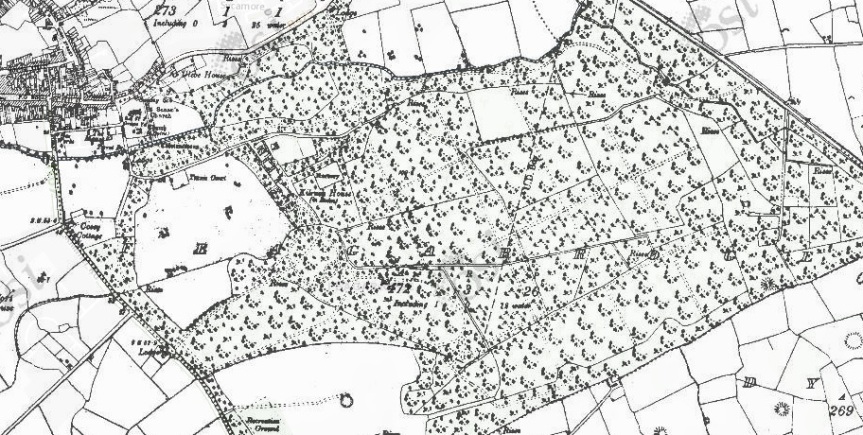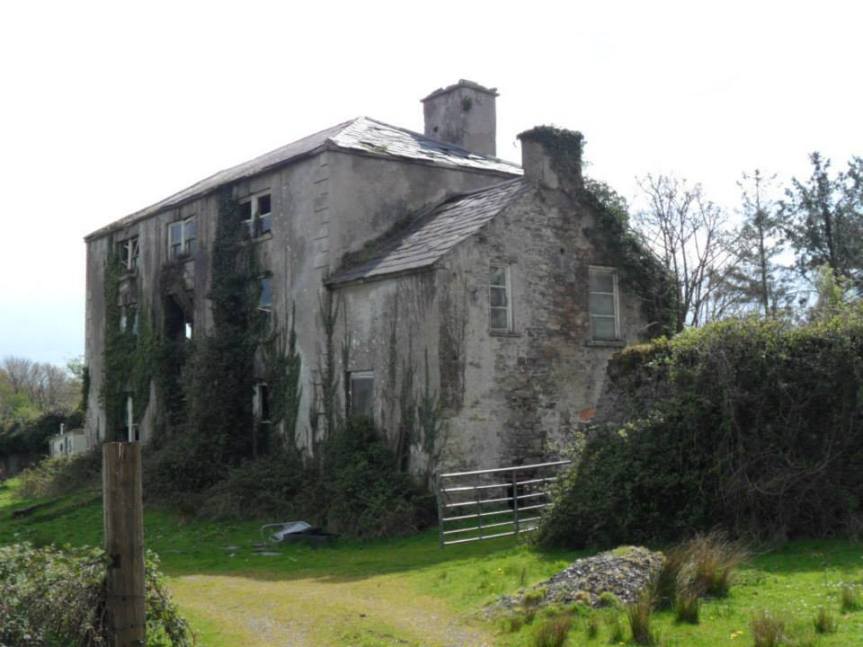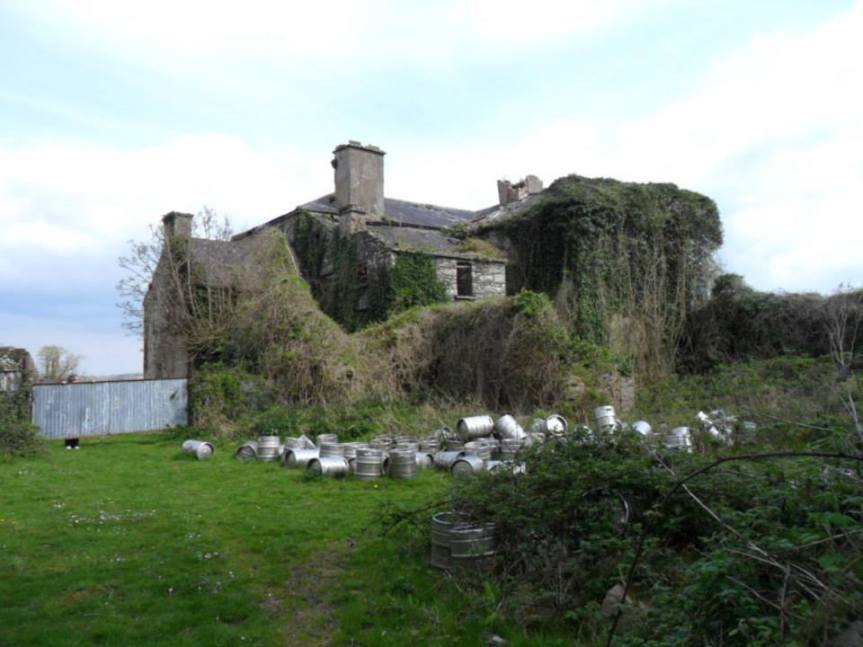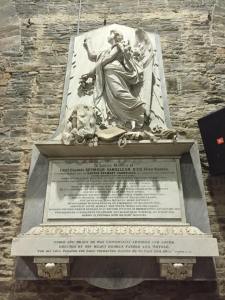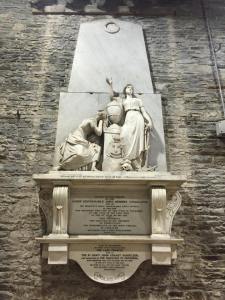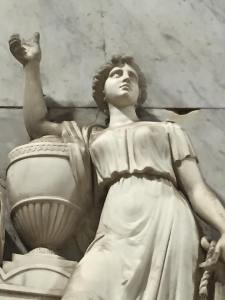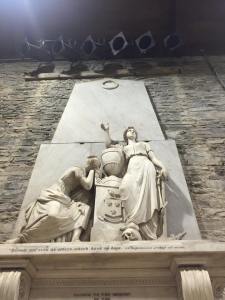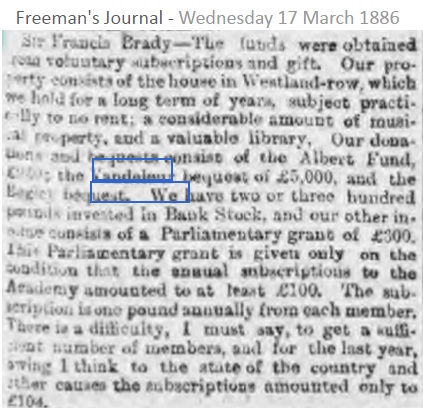Another forgotten Kilrush person.
John Meagher (1836-1920), storekeeper and politician, was born on 8 December 1836 at Kilrush, Clare, Ireland, son of Roger Meagher, fisherman and coastguard, and his wife Catherine, née Mahoney. He arrived in Sydney about 1863 and at St Mary’s Cathedral married Mary Ann Byrne (d.1895), housekeeper, on 19 September 1864.
Aside from his business interests, Meagher was active in local politics as a Protectionist. In 1896 he was a vice-president of the committee that sponsored the People’s Federal Convention at Bathurst and entertained in his home many leading Federationists. Nominated to the Legislative Council in 1900, Meagher proposed the building of the Temora-Wyalong railway line and was a vocal advocate of state aid for Catholic schools. He identified himself closely with the Irish Home Rule movement and frequently visited Ireland, making his last visit in 1919-20.
He was prominent in greeting Irish delegates to Australia such as John and Willie Redmond, John Dillon and Michael Davitt. Close personal friendships developed between Meagher, his family and William Redmond. In 1916 Meagher deplored ‘the ruthless execution of the leaders’ of the Easter rebellion in Dublin and strongly opposed conscription.
He remained in contact with individuals from his native Kilrush, in particular with the entrepreneurial Glynn family. A number of his letters to Charles E. Glynn survive in the Glynn family archive.
Meagher was a devout Catholic, a daily communicant throughout his life, a generous donor to Catholic Orders and organizations, notably to the Sisters of Mercy when they were building their novitiate and establishing an orphanage at Bathurst, and to St Stanislaus’ College. In December 1903 he was appointed knight commander in the papal Order of St Gregory the Great. A ‘sterling, big-hearted Irishman’, he continued to champion Irish-Catholic causes through years when sectarianism was a familiar tension.
Meagher died on 26 August 1920 in St Vincent’s Hospital, Sydney, and was buried in the family vault in Bathurst cemetery. Predeceased by his only daughter who had become a religious of the Sacré Coeur order, he was survived by five of his seven sons. His estate was valued for probate at £44,737.
(Source: Bruce Pennay, Meagher, John (1836-1920) in Dictionary of Australian Biography, available at: http://adb.anu.edu.au/biography/meagher-john-7545)
Meagher remained firmly involved in the attempt to introduce Home Rule in Ireland as the following notice confirms:
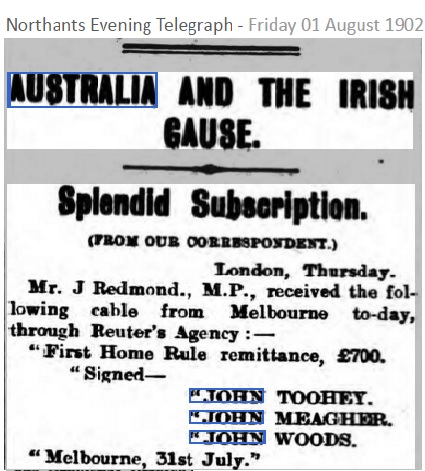
As late as June 1914, and in his eightieth year, Meagher visited Ireland to witness the opening of the new Irish Parliament (which of course, did not happen as a result of the outbreak of the First World War). The following article describes Meagher’s visit:

Meagher’s second son, Michael, married into the prominent Foley family of Kilrush, in 1888:

The Churchyard, Kilrush is the burial place of Meagher’s father-in-law:
Erected by John Meagher, Bathurst, Australia, to the memory of his father-in-law, Francis Byrne who died 2 December 1874, aged 70 years. May his soul rest in peace Amen. (Location: South west section opposite back of church)
John Meagher’s obituary
Sydney Morning Herald, 27 August 1920
DEATH OF MR. JOHN MEAGHER, M.L.C.
PROMINENT IRISHMAN
Mr. John Meagher, M.L C., of Bathurst, died in St Vincent’s Private Hospital, Sydney, early yesterday morning, at the age of 84 years.
Mr. Meagher was born in Kilrush, County Clare, Ireland, and arrived in Australia at the age of twenty-nine years. He remained in Sydney for about a year, and then went to Bathurst with the population that was slowly moving over the mountains. He entered the employ of Mr. Edmund Webb, founder of Webb and Co., general goods traders, and subsequently, at the age of 31, established a business of his own, this being the nucleus of the existing establishment of John Meagher and Co., of which he was governing director. Simultaneously he opened up stores on the various goldfields during the boom days, including Hill End, Carcoar, and Trunkey. The journey from centre to centre was most perilous and difficult in those days, but Mr. Meagher paid regular visits on horseback, and recorded some unusually fine riding feats. He subsequently established businesses at Barmedman, Wyalong, and Temora, and acquired another at Forbes. The firm also operated in Sydney. He married in 1864, and of the seven sons and a daughter, five sons survive.
Mr. Meagher took a prominent part in the public affairs of Bathurst, and was a notable figure among the identities of that city at the Jubilee celebrations in November, 1912. He contested the Bathurst seat in the Legislative Assembly against Sir Francis Suttor in 1885, but was defeated. He was appointed to the Legislative Council by the Lyne Government in June, 1900.
Mr. Meagher always identified himself closely with the Home Rule movement. He was one of those who welcomed Messrs. John and William Redmond, the first Home Rule delegates to Sydney, in 1883, and he was also prominent in greeting later delegates, including Mr. John Dillon, Sir Thomas Esmonde, Mr. Michael Davitt, and Mr. W. A. Redmond.
While he was a large employer, his political leanings, he frequently said, were towards Labour. On one occasion many years ago he organised a meeting in Bathurst, at which £100 was collected to help the London dockers, then on strike. He was extremely generous in his assistance to Roman Catholic charities, and some years ago purchased from the Busby estate the “Logan Brae” mansion, a handsome building standing on 25 acres on an elevated site overlooking Bathurst, and presented it to the Sisters of Mercy as a novitiate. He also partly purchased the present orphanage.

(Photo credit: http://www.rahamim.org.au/house/)
“Logan Brae” mansion, the property was bought in 1909 by Mr John Meagher MLC and donated to the Sisters of Mercy for use as a formation house and teacher training facility for young Mercy novices.
Meagher received the decoration of Knight of St. Gregory from the Pope for his many services to the Church.
Mr. Meagher has left five sons. Four of those – Messrs. Michael, Peter, John, and Martin Meagher – have shared with him the direction of the business of John Meagher and Co., while the remaining son, Mr. Patrick Meagher, is a solicitor. Mrs. Meagher died many years ago and the only daughter, who was a nun, is also dead. The body will be removed from Sydney to Bathurst this afternoon. It will remain in St. Michael and St. John’s Cathedral for the night, and be interred in the Bathurst Cemetery on Saturday morning.
REFERENCES IN PARLIAMENT
In the Legislative Assembly yesterday afternoon the Premier (Mr. Storey) announced the death of Mr. Meagher, M.L.C. For many years, he said, the deceased had occupied a seat in the Legislative Council, and he had been an old and respected colonist of this State. Members would agree, he said, that Mr. Meagher had performed great services as a citizen, as a business man, and as a champion of everything that was for the betterment of Australia. In those regards the deceased had no peer. It was, therefore, fitting that a message should be sent to the relatives conveying the condolences of the members of that Chamber.
Sir George Fuller (leader of the Opposition) said he wished to endorse what the Premier had said about so distinguished a citizen of the State. The deceased had done much to help forward the development of New South Wales. Mr. Wearne (leader of the Progressive party) said that the death of men of the stamp and importance of the deceased was a great loss to the counsels of the State.
The Catholic Press of 2 September 1920, devoted an entire page to Meagher’s obituary and included this photograph of him:

This is the accompanying article:
John Meagher of Bathurst: Death of a Great Irish-Australian
News of the death, of the Hon. John Meagher, M.L.C., K.C.S.G., in St. Vincent’s Private Hospital, on Thursday morning last, came as a surprise, even to those friends who had observed that he had grown noticeably feeble since his return from Ireland a few months ago. Though his eyesight was failing, and he needed a companion to guide him in public, he was still regular in his attendance at daily Mass, whether he was in Sydney or in Bathurst. But he was not the man to give up while he had breath. He was present at the last Corpus Christi celebration at St. Patrick’s College, Manly, and more recently took an active part at the opening of the Bathurst Show. About a fortnight ago, Mr. Meagher left for Sydney, on private business, and visited St. Vincent’s Hospital, incidentally to have his eyes attended to. He was admitted as an in-patient in order that he might receive the most careful attention. Soon after admission, however, his health began to break down generally, and his condition for the last few days had been causing his family much anxiety. Mr. Michael Meagher and other sons had been spending as much time as possible with the father, and only on Wednesday night, after paying a hurried visit to Bathurst on important business matters, Mr. Michael Meagher hurried back to Sydney, but reached there in time only to hear that his father had passed away in his sleep, with that peace and tranquility that had characterised his life.
A Sterling Irish-Australian.
The late John Meagher ‘s reputation as a sterling Irish-Australian was well known far beyond the boundaries of his own State. Throughout the Commonwealth, and in Ireland and the United States, he was recognised as, perhaps, the leading representative of Irish racial opinion. He possessed a national instinct for ascertaining the right course. With John Meagher, to recognise a duty was to do it. On his frequent visits to Ireland he was always given a princely reception by the most eminent men in the land, while newspapers and magazines from North to South were ever eager to publish his interesting and enlightening views. For he was a delightful and versatile conversationalist; a student of patriotic literature and national and international politics, as well as a born traveller and a keen observer.
In Australian public life, Mr. Meagher ‘s opinion was always valued for its shrewdness, honesty, and disregard for subtlety. He held very definite principles, and never hesitated to declare them, though he was over kindly and considerate to those who failed to see eye to eye with them, as long as he believed them to be straightgoers. Shufflers ever lived in fear of his criticism.
Born at Kilrush, County Clare, Ireland.
The late Mr. John Meagher was born at Kilrush, Ireland, and on 5th December next would have attained his 85th birthday. He came to Australia at the age of twenty-six, and after staying in Sydney for about twelve months, he took part in the movement known as‘Population West.’ He entered the service of the late Edmund Webb, in Bathurst. A little later he entered the employ of Mr. Mears, also a Bathurst storekeeper. Subsequently he entered into partnership with Messrs. Mangan and Keitin as joint goods vendors. Mr. Keitin, who was manager of the firm’s Trunkey branch, died a little afterwards, and Messrs. Meagher and Mangan carried on the business. Fifty years ago Mr. Meagher became the owner of a small grocer’s shop in George street, Bathurst, where Mockler Bros, are now established, and after trading there a few years, the business was removed to Howick-street, where it was continued under the title of John Meagher and Company. In the early days, Mr. Meagher traded with the smaller centres round Bathurst, and did a large business at Hill End at the time of the gold rush. He also started shops at Trunkey and Locksley, then known as Dirty Swamp, before the western railway had reached there. It was usual for Mr. Meagher to ride on horseback from Bathurst to Hill End over a rough and dangerous route, now known as the Bridal Track, and to other places to which he was interested and which, the bushrangers frequently menaced. It was usual for him to rise early. He was then a young man, and used to ride from Bathurst and have breakfast at Hill End, fifty-eight miles away. When the gold rush was on, Mr. Meagher opened branch businesses at Barmedman, Temora and Wyalong, and in more recent years, acquired an established business at Forbes.
An Irish Romance
He married in 1864, his wife having come out from Ireland, where the pair, had met in their youth. Mr. Meagher was predeceased by his wife by nearly twenty-five years, as well as his only daughter, who was a religious at the Sacred Heart Convent, Rose Bay, and who died about eight years ago. He is survived by five sons, namely, messrs. Michael (Bathurst), Peter,(Temora), John (who is at present on his way to America, having left Australia by the Niagara only a few days ago), Martin (Manly), and Patrick (solicitor, of Temora).
Mr. Meagher first entered the political arena against Sir Francis Suttor for Bathurst, but was defeated. It is twenty years ago since Mr. Meagher was appointed to the Legislative Assembly. He was a man of wide generosity, and proud of Australian citizenship. In connection with the centenary of Australia he provided the entire expenses of the Bathurst celebrations, which included a picnic to 1,500 school children. It is interesting to record that while Lieutenant Parer was in Italy, it was Mr. John Meagher who acquainted him of the British authorities’ permission for him to undertake the flight from England to Australia. And as Parer and Mclntosh circled around Bathurst on their way from Sydney to Melbourne, John Meagher ‘s cortege was proceeding from the railway station.
The late Hon. John Meagher, M.L.C., K.C S.G.
The Hospitality of ‘Kilrush’
The hospitality of Mr. John Meagher at ‘Kilrush’ has become, widely known, especially to distinguished prelates and politicians visiting Bathhurst, he took a prominent part in the Federal Convention, and entertained a number of men whose names will ever be associated with it. Among the guests at his house on that occasion were Sir Edmund Barton, Mr. (now Senator) Millen, Cardinal Moran, Sir John Quick, Sir William Lyne and Sir John See. During the visits of the past and present Apostolic Delegates, they were guests at ‘Kilrush,’ where they were enabled to meet all the representative people of the west of every religious and political creed. The various Irish delegations for the past forty years have always made a Mecca of ‘Kilrush.’ During the historic visit of John and William Redmond, when so many weaker men shirked public association with them, John Meagher took his stand resolutely by their side in the west, in spite, of jingo threats and attacks. At later periods, John Dillon, Michael Davitt, Devlin, Hazleton, Donovan and John Redmond’s son never forgot their visit, to Bathurst. We believe it was John Dillon, when recounting his Autralian itinerary, who described Bathurst as ‘the place where John Meagher lived.’ It was characteristic of Mr. Meagher’s unerring Irish instinct that when so many wavered, and even in Ireland opinion was in doubt, he declared himself on the side of the men who died during Easter Week, 1916.
In him Ireland has lost one of her greatest champions in Australia. His great generosity. His splendid generosity to the Church all over Australia will never be fully known. For many years, whenever a school was opened, or a church was to be built in Bathurst or Goulburn diocese, or a charitable foundation in other, states, John Meagher gave his £25, £50 or £100, and his benefactions extended also to many other dioceses. When he was just beginning business over fifty years ago, he put £200 on the foundation stone of St. Mary’s Convent. He contributed £100 to the building of St. Philomena’s School; £600 to the Bathurst Orphanage; and his crowning act of generosity was the presentation of the beautiful building of St. Joseph’s Mount to the Sisters of Mercy, at a cost of £3000. The late Bishop Dunne and his predecessors held him in the highest esteem. When Mr. Meagher went to Ireland in 1907, and it was anticipated that the Home Rule Act would be put into force, Dr. Dunne wrote him a letter, stating: ‘I will not feel my absence from the celebrations if you undertake to represent me personally and our Catholic people in this diocese. It will make me feel that we will be adequately represented, when we know we have a representative of such excellent capacity and such an ardent and uncompromising champion.’ For his services to the Church, Pope Leo XIII, conferred on him the honour of Knight Commander of the Order of St. Gregory the Great.
The Requiem.
The body was taken to St. Mary’s Cathedral, where a Requiem Mass was celebrated on Friday morning by his Lordship the Bishop of Wagga (Right Rev. Dr. Dwyer, after which a cortege was formed, and proceeded to the Central Station, to catch the 9.25 a.m. train for Bathurst. Among the priests who took part in the ceremonies were the Right Rev. Monsignor Ormond (representing the Apostolic Delegate; the Rev. Father P. J. Murphy (Adm, St. Mary’s Cathedral), Very Rev. Father J. B. Kennedy (Commissary Provincial of the Franciscan Fathers), Very Rev. Father M. J. O’Reilly. CM. (Rector of St. John’s College, Sydney University), Rev. Fathers T. Fitzgerald, O.F.M., H. McGee. O.F.M., T. Brown. C.S.S.R., R. Collender. P.P., John Meagher, S.J. (grandson). Among those present in the church and at the railway station were Messrs. Peter, Michael and Martin Meagher (sons of the deceased), Sir William McMillan. K.C.M.G., Sir Thomas Hughes, M.L.C., Mr. J. D. Fitzgerald, M.L.O., Mr. J. Lane Mullins, M.L.C.. Mr. John Travers, M.L.C., Mr. James Mitchell (Inspector-General of Police). Captain G. F. Hughes, M.C., A.F.C., Dr. John Flynn, Messrs. W. J. Spruson, P. J. Minahan’, M.L.A., P. S. Cleary (President, Catholic Federation), J. E. Burke (General Secretary, A.H.C. Guild), P. O’Loughlin (General Secretary, Hibernian Society). J. J. Carroll, R. J. B. Stephens and N. Stephens.
The Obsequies. IMPRESSIVE CEREMONIES
On Saturday morning a Solemn Pontifical Office and Requiem Mass was sung at SS. Michael and John’s Cathedral, Bathurst, which was crowded with a representative congregation, including prominent members of different churches. This feature, and the extraordinary dimensions and the character of the funeral cortege were a true reflex of the universal esteem in which the late Mr. Meagher was held. At 8.30 a.m. the Office for the Dead was commenced, the Right Rev. Monsignor Long, V.G. (Wellington), presiding. The Pontifical Requiem Mass followed immediately, and was celebrated by the Right Rev. Dr. Dwyer (Bishop of Wagga). The Rev. Father N. Cooney was deacon; Rev. Father McKeon (Orange), sub-deacon ; Rev. Father J. Murphy (Adm., St. Mary’s Cathedral, representing the Apostolic Delegate and the Archbishop of Sydney), was assistant priest; Rev Father J. F. Norton, B.A., was master of ceremonies; Rev. Father C. Loneragan was Magister Choralis, assisted by the Rev. Father Brosnan (Adm., Orange). The chanters were Right Rev. Dr. Br.ophy (Dubbo), Right Rev. Monsignor Killian, V.G. (Broken Hill), Very Rev. Father E. J. Flanagan, P.P., V.F., (Mudgee), Rev Fathers O’Keefe (Carcoar), Corbett (Sofala), Eviston (Wellington), Cooney, Norton, and Loneragan (Bathurst), Lawler (Molong), Crowe (Rockley), Hall, CM., Gallagher, CM., and Rev. Dr. Wigmore, CM. (St. Stanislaus), The Very Rev. Father M. J. O’Reilly, C.M. (Recter of St. John’s College, University of Sydney), Rev. Father F. S. McNamara, O.F.M., M. McNamara (Waitematta), and J. B. Howard, B.A. (Cowra).
The Panegyric. FATHER O’REILLY’S ELOQUENT TRIBUTE.
At the conclusion of the Mass the Very Rev. Father M. J. O’Reilly, C.M. (Rector of St. John’s College, within the University), delivered an eloquent panegyric. Taking for his text, ”Strive for justice for thy soul; even unto death fight for justice, and God shall overthrow thy enemies for thee’ (Eccl. iv.-33), Father O’Reilly said that he was there that day to say a few words of farewell over the mortal remains of the man whom they best knew as ‘John Meagher, of Bathurst.’ He was there as a friend of over twenty years’ standing, a man for whom he had an affectionate — he could almost say filial — regard, and from whom he had received many benefits. He was there to prove that the adage ‘eaten bread is soon forgotten,’ was not always right. It was many years ago since he had first received of Mr. Meagher ‘s bounty, and if there were no other reason that alone should have brought him, not only from Sydney, but from Carpentaria. He spoke, therefore, not merely as a man speaks for his friend, but with more than a personal regard which was touched with what he might call veneration; a veneration of one that had proved himself a magnificent type of man and Catholic. But he had also to speak of him in another capacity, because he felt that as he had been asked to speak that day, he was expected to discharge a public duty as well. Standing in that pulpit, he was expected to remember what John Meagher had been to the Irish and the Catholic people of Australia, and he felt that it would be a singular want of gratitude if they were to allow his remains to be laid in their grave without making some acknowledgment of the benefits they had received from him, and without pointing out some of the lessons of which his life had been an illustration. He was reading the office for the day when he suddenly alighted on the words of the Holy Spirit, ‘Strive for the soul; and even unto death fight for justice, and God will overthrow thy enemies forthee.’ There was not a more fitting text from which he could proclaim the singular merits of John Meagher of Bathurst. Above All, a Christian. John Meagher was a man who strove for justice to his soul, a man who, literally speaking, set first the Kingdom of God, confident that all other things should come therewith. Above and before all things, John Meagher was a Christian. No matter how engrossed in business affairs, and there was no keener business man than he, he never lost sight of that great good of human endeavour. He was minutely faithful, and a Catholic to the backbone; to the spinal marrow. He lived in an atmosphere of faith, and saw all things from a point of view of faith. He pursued his whole life without flinching, without pretence, humbug or cant, but with that rude sincerity that was so characteristic of the man. Making no boast, making n0 parade, his life was an expression of deep religious sentiment which was to his existence as the soul to the body. And now, no doubt, he had received his reward. They were not merely there to pay a last tribute in the highest sense of the word, but to hasten that time when the soul of John Meagher, if it were not there already, would be admitted to the sight of God, Whom he served so faithfully, and so well. There were few wealthy men who were generous according to their means. John Meagher was one of the exceptions, and there were only about half-a-dozen of them in Australia. ‘Unfortunately,’ said Father O’Reilly, ‘and I take this opportunity of saying it, the worship of the golden calf occasionally finds its way into the pulpit, where homage is paid to wealth, because of the power behind it; the inclination to discover merits in wealthy men, because they are wealthy men. It is a form of worship, and there is nothing more contemptible, than when it is found in the holy place. ‘Personally,’ he added, ‘I feel that many wealthy men will be damned. It seems a crude way of putting it, but it is not nearly so crude as it is put in the Gospels. I say this, because when men become wealthy there often comes a change over their lives. They become heartless, callous, singularly devoid of love, and brutal. Christian charity seems to dry within them. Not so with John Meagher. He was a wealthy man, and yet there was always manifest the milk of human kindness in his character.’
The Fight for Justice.
Father O’Reilly warned his congregation not to believe any man that told them that there was any way of obtaining justice than by fighting for it, whether in the civil sphere or outside of it. In saying this he was not speaking at random, but from much experience. There were people in Australia, as there were people everywhere, whose motto was peace. Their cry was, ‘Give us peace in our day;’ but it was not peace with honour they wanted, but peace at any price. There were craven souls who have themselves all that they want in this world, and do not wish to be disturbed in their comfortable apathy. These were the wretched people who told others, not to make a row; not to create disturbance; not to raise their voice against injustices, because they (the craven souls) were awfully comfortable as they were. Men who generally spoke like that were wealthy men who feared that if injustices were remedies, they might have to disgorge some of that wealth. Christ Himself declared that He had come from heaven to earth, not to bring peace but the sword. Holy Job declared that life upon earth was a warfare, and if it ceased to be so it would be an indication that man was prepared to accept the reign of iniquity, and sink into degradation. When he was not prepared to fight he must become an accessory after the fact. Therefore, they could go back to the words of the Scripture. ‘Even unto death fight for justice,’ &c. That was an epitome of the life of John Meagher, who, may it be said to his credit, was a fighting man. He was not aggressive; he was not a man who provoked aggression; but he was not a man who could be cajoled by flattery, bought with attractive promises or intimidated by threats. He always nailed his colours to the masthead, from where, despite tremendous odds at different times, they never came down. John Meagher never cared who knew he was a Catholic and an Irishman; and in the championship of his faith and nationality throughout many years, despite the menaces of their enemies, when the dogs of sectarianism were unleashed upon the Catholic of Australia, just as they were being unleashed at present, he never faltered. Of Unchangeable Character. There was no man more susceptible to criticism than a business man. John Meagher was a business man, but he was never purchased, never intimidated. In Bathurst fifty years ago he was the same; when trading in a small way when his attitude was perilous to his success, he, was just the same. When people were punished for their love of country he was just the same. At the time of the shooting at the Duke of Edinburgh by the madman, O’Farrell, for which the Irish people, who were no more to blame than those present at church that day and then unborn, were once again victimised, John Meagher stood firm.
The Bishop of Bathurst at that time went on to a public platform to declare his loyalty, and the loyalty of the Catholic people, and was howled down for his pains. That Bishop made a mistake. The loyalty of a Catholic, such as it was, should not be taken for granted. Catholics should not have to give any assurances that were not expected of other denominations. He (Father O’Reilly) was not mentioning these things to-day to revive bitter memories, but to pay a necessary tribute to a deceased champion. Mr. Meagher went through it all when the Redmonds came to Australia and Bathurst; and the bitter periods that followed, when he proved the same fearless, dauntless and unwavering Irishman, true to his country and faith. If anyone said he (Father O’Reilly) should have omitted these things, his reply was simply that he could not have paid his tribute without doing so. He would go further, and say, ‘It pays to be honest.’ Many people did not think so. But John Meagher had proved it. There were men there that day who had disagreed with Mr. Meagher — he could see them — and he had himself sometimes disagreed with him; but there was not a man in Bathurst, certainly not a citizen of Bathurst, but who could speak of him except with respect and admiration. In conclusion, he would ask them to follow beyond the grave with their fervent and affectionate suffrages the soul of the great Catholic Irishman who was dead, and of whom it might be said, without any reflection on the living, that he had left a gap in the ranks of the Catholic laity of Australia that there was nobody left to fill. At the close of the sermon the last Absolutions were pronounced by the Bishop of Wagga. The Bishop and clergy then preceded the remains, conveyed by the representatives of the Hibernians and Guild, to the hearse.
The Funeral. BATHURST MAKES HISTORY.
The funeral procession, which was proclaimed by the Mayor of Bathurst to be of a public character, was declared by old residents to be the largest, most widely representative, and spectacular ever seen in Bathurst. The cortege, which proceeded from SS. Michael and John’s Cathedral, via Keppel and Stewart Streets, and Memory Drive, to the Catholic portion of the Bathurst Cemetery, was headed by a processional cross, the cross-bearers being the Rev. Father McKeon (Orange), with Rev. Father J. F. Norton, B.A., as marshal. Acolytes, in surplices and soutanes, followed. Then came a large body of children, representing the Catholic schools in Bathurst, including the Patrician Brothers’ High and Primary Schools, St. Mary’s College and St. Joseph’s, and St. Philomena’s Schools, concluding with about 120 students from St. Stanislaus’ College, under Prefect W. Cantwell. Next, came a squadron of mounted police, in regalia, wearing special dark puggeries on their white helmets. A large muster of the District Band, under the directorship of Bandmaster S. Lewins, in full uniform, came immediately behind the police, and played the ‘Dead March.’ Mr. A. Pearce was in charge of about forty male employees of the firm of Messrs John Meagher and Co., Ltd.; the only employers most of them had ever worked for. Some had seen service with the firm for over a score of years, and there were one or two whose service approached twice that length of time. The Federal Parliament was represented by Mr. S. Nicholls. M.H.R., and the State Parliament by Mr. W. E. Clapin, Usher of the Black Rod, representing the President, members, and officers of the Legislative Council. There were also present Mr. F. Jaques Smith, M.L.C., Dr. Foley (Cowra), Mr. E. Loneragan (Mudgee), and Mr. R. M Loneragan (Gulgong). The Bathurst Municipal Council was represented by the Mayor (Alderman F. Havenhand), Alderman A. T. Tipling, A. E. Ennis, W. S. Hodge, W. Boyd, and C. Hansard, and Mr. F. J. Tonkin (Deputy Town Clerk). Mr. J. W. Percival represented the directors of the ‘National Advocate’ and the Executive Council of the A.L.P., and Mr. J. O’Neill, the Turon Shire Council. The Children of Mary, numbering nearly 100, wore their pale blue cloaks. The A.H.C. Guild under Warden Dryden and Secretary Eviston, and the Hibernian Society, under the president (Bro. M. O’Connell), and the secretary (Bro. J. Fish) were present in large numbers, and marched four deep. Then came the clergy in cars, and representatives of the other churches, including Mr. J. D. Walker, representing Bishop Long, and the Anglican Church; the Rev. Pendleton Stewart, the Presbyterian Church; the Rev. W. Deane and J. W. Daines, the Methodists; the Rev. James Harper, the Congregationalists, and the Rev. J. Hunter, Baptist. Following the motor-hearse were members of the family, including Messrs. Peter Meagher (Sydney), Michael Meagher (Bathurst;, Patrick and Martin (Temora), sons; and the Rev. Father J. Meagher, S.J., Mr. P. J. Meagher (Forbes), P. F. Meagher (Bathurst). Anthony J. (Barmedman), and Michael (Bathurst), grandsons. Other representatives of firms or societies were: Messrs. L. Edgley, W. Richardson. W. H. Webb, L. J. Mockler, W. Yeo. H. Mansell, Dr. Machattie (president), Messrs. R. M. Lindsay (secretary). J. H. McIntosh (representing the Bathurst Turf Club), Mr. J. Green (Bathurst Football League), Mr. C. H. Bennett (Bathurst Cricket Association), Messrs. C. R. Brett (treasurer) and J. J. Sullivan (A. H. and P. Society), C. Boyd (P. P. Board), Mr. Fuller (SS. Michael and John’s choir). M. Eviston, W. Yeo and H. Mansell (Bathurst Trotting Club), Messrs. J. Lupp and C. Briggs (Bathurst Gun Club), Mr. L. Cotter (Sydney Hibernians), Mr. W. Dryden (St. Vincent de Paul’s Society), Mr. A. E. Pollard, in regalia (the Protestant Alliance), Mr. P. Crowe (Bathurst Labour League). Messrs. A. B. James (treasurer), and J. B. Eviston (Bathurst District Hospital). Public officials present included: Inspector General Mitchell, and Mrs. Mitchell (Sydney), Messrs. F. W. C. Crane, S.M., J. D. Walker, C. M., Superintendent Thorn., and Mr. G. Steele, (Governor, Bathurst Gaol), Messrs. C. R. Barry and V. W. Ryrie (Commercial Banking Company). Others, present included: Drs. Brooke Moore, H. Busby and H. J. Harris, G. F. Baur and Olive Thompson, Messrs. A. and E. Sullivan, (of Avoca), Mr. T. J. Dalton, K.C.S.G. (Orange), C. Culnane (Kelso), Mr. and Mrs. R. J. Fagan and Miss Fagan (Durama iiu). Mr. T. J. Purcell (Sydney), Mr. Fred. O ‘Driscoll (Sydney)’, Mr. J. Casey (Orange). Mr. J. Allman (Orange), Mr. J. Mahoney (Temora), Messrs. John McPhillamy, Frank Bathurst Gaol, Messrs. C.R. Barry and V. J. Hurley, W. Courtney, P. Chifley, H. and E. Mugridge, O. Bayliss, F. Blomfield, J. Green, Mr. and Mrs. Jas. McHugh and R. McGill. Message from Archbishop Mannix. Mr. M. Meagher received a cable on Tuesday morning from Archbishop Mannix from London. The cable was as follows: ‘Deepest sympathy, Ireland,Rome, Australia, mourn John Meagher. (Sgd.; Archbishop Mannix’).
References in Assembly. AN UNPRECEDENTED TRIBUTE.
The high esteem in which the late John Meagher was held in political circles was shown on Thursday afternoon in the Legislative Assembly. For the first time in history, reference was made in this Chamber to a member of another branch of the Legislature. Mr. Storey, Premier, announced with regret the death of Mr. Meagher. He pointed out that it was unusual for members of this House to refer to the death of a member of the other Chamber, but he thought that, in the circumstances, members would forgive him making reference to the sad event. Mr. Meagher, he said, was one, of the oldest and most highly respected of New South Wales colonists, and was an excellent citizen in every respect. He paid a high tribute to the worth of Mr. Meagher, and asked the Speaker if he would convey the sympathy of members of the House to the family of the deceased in the great loss which they and the State had suffered by his death. Sir George Fuller, leader of the Opposition, supported the Premier’s remarks, and said that Mr. Meagher had done much in the interests of the State and its development. Mr. Wearne, leader of the Progressive Party, also expressed sympathy with the family of deceased, and said that although he had only known Mr. Meagher for a comparatively short time, he knew of his fine record of citizenship. Tribute from St. Stanislaus’ College.
A FAITHFUL FRIEND OF THE BOYS.
The Bathurst ‘National Advocate’ publishes a tribute to John Meagher from the Vineentian Fathers, St. Stanislaus’ College, Bathurst, which contains the following passages: Like very many other Catholic institutions in Australia, and especially in New South Wales, we have had experience of generous assistance from his ever-open purse when most need of it was felt. Perhaps, however, the memory that will live longest with us, because of the influence his example had on many a young and impressionable mind, is his childlike devotion, when he took his place of honour within the sacred precincts of the sanctuary at any of the religious functions in our college chapel. To see him kneeling in rapt devotion — this man who had made his way in the world to a position of affluence and power — this man who was ever an honoured presence amongst the great men of the land, ecclesiastical, commercial, political — this man whose name was known and honoured in ancient lands far across the sea, and to whom the doors of the great were over open even when men disagreed with his views — to see such a man, with all the honours of the years thick upon him kneeling in humble devotion, like a child, at the sacred ceremonies of the Church, has ever been a striking example to the boys who were being educated within these walls, and it is no mere outpouring of obituary eulogy to say that many a young life will have found inspiration to climb to higher and better things because of the glorious example of the late Hon. John Mcagher. This is why we grieve with those nearest to him that his life has closed — this is why we hold his name and memory in affectionate remembrance — this is why we pray today, and long will pray, that the ‘reward exceeding great”is his, from the hand of the Lord Who bade as become as little children if we wanted to enter into the kingdom of heaven. — R.I.P.


